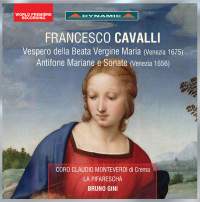Texte paru dans: / Appeared in: |
|
|
Outil de traduction ~ (Très approximatif) |
|
|
Reviewer: Bertil
van Boer
In Venice during the 17th
century, opera became the dominant musical form, especially with the rise of
a number of theaters. At the end of his long life Claudio Monteverdi rose to
the occasion to write three last works that have been seen as the trilogy
that pretty much started the fame of the new genre in that city. Though this
is a simplification of the gestation of Venetian opera, his work did point
the way for his younger successors to achieve success and fame in the years
that followed. Certainly, the most important of these was Francesco Cavalli,
born Francesco Caletti-Bruni. At an early age, he was mentored by Federigo
Cavalli, whose last name he took following the success of his first opera in
1639 at the Teatro San Cassiano. One should note that this is about the same
time that Monteverdi also wrote his trilogy, so it would appear that these
two composers of separate generations were colleagues at that point in time,
though Cavalli probably studied under the elder man for a number of years
prior.
For all of his fame as an
opera composer, leading up to a special journey at the request of French
Cardinal Mazarin in 1660, which arguably was a seminal event in the
development of the French Baroque opera despite its poor reception, Cavalli
made his daily bread as an organist at St. Mark’s. In that post, always
considered secondary to his work for the stage, he was also an important
figure in the particular divided choral style practiced at the basilica.
Indeed, when he finally achieved the position as maestro di cappella there,
he was obligated to compose sacred works. This disc covers two sets, Vespers
dedicated to the Virgin Mary (the first of three of these) and a series of
Marian antiphons, replete with two instrumental interludes. The Gabrielian
musical legacy is strong in each of these sets, the latter published in 1656
when Cavalli was at the height of his career and the former appearing in
1675 shortly before his death. In keeping with the probable usage of both
sets, this recording intersperses the antiphons with the Vespers setting,
saving the instrumental portions for after the Magnificat when they bookend
the most important of the Marian texts: the Ave Regina caelorum, the Regina
caeli, the Salve Regina, and the Alma redemptoris mater. Each pairing begins
with by a plainchant incipit, which sets the tone for each movement pair of
antiphon-Psalm. There is a certain stylistic continuity with each of the pairs, which is not surprising given that their intended venue was that echo chamber called St. Mark’s. But on occasion Cavalli knows how to vary dynamics and textures, even as his compositional technique has to be limited to antiphonal effects or homophony. For example, in the Dixit Dominus the cautious use of soloists versus the dual choruses (accompanied by instruments) lends a nicely solemn tone, which is interrupted momentarily by some scaffold solo entrances that sound madrigalistic. In the Nigra sum, a lovely paean to the beauty of women, only the plainchant is left, with the more contrapuntal Laetatus sum providing the wonderfully-textured antiphonal choral response, only this time with more contrapuntal content. The chant for the Ave Maris stella is about as lyrical as one might wish, with a flowing line that is done responsorially by the men’s choir, which makes the antiphon Virgo potens move smoothly into the final canticle, the Magnificat. Here Cavalli offers a chorale-like opening that evolves slowly into the sort of divided chorus, somewhat muted and respectful in tone. This in turn gradually increases in complexity and texture until the final section, where the tempo increases and the rhythm becomes much more of a dance than solemn chords (though these too appear at the Amen). The two instrumental pieces seem a throwback to the time of Gabrieli, with good brass ensemble work and imitative structures.
The
performance by both the Monteverdi choir and the divided brass choirs is
nicely integrated, with each sound complementing the other, making it
especially noticeable during the antiphonal effects. Of course, La
Pifarescha does mainly consist of a quartet of trombones over which hovers a
cornett, and the continuo groups, a pair of organs accompanied by a lighter
viola for the first choir and a bass viol for the second, functions as a
solid bass. The voices in the so-called cori favorite, known as the
soloists, are all clear in their diction and blend well together. This may
contrast with Cavalli’s use of such in his operas, but here they act well as
a foil for the thicker dual chorus textures that he uses in alternation
throughout. There seems to be a bit of sameness in Bruno Gini’s tempos, but
I find that he has hit a sweet spot wherein the bulk of the music depends
upon the contrasts of texture more than abrupt changes in tempo to carry the
music. He does, of course, speed things up incrementally from time to time,
particularly in those brief madrigal sections, but in general he has hit
upon the right tempo for such divided choruses to function. If one is
expecting the Cavalli of the stage, with his often naïve and dramatic
gestures, this disc will prove his versatility. In addition, it demonstrates
that he is the standard-bearer of the Venetian choral tradition beyond
Gabrieli, imbuing it with a new life. This is one recording that will set
this record straight. | |
|
Support us financially by purchasing this disc from eiher one of these suppliers. Un achat via l'un ou l'autre des fournisseurs proposés contribue à défrayer les coûts d'exploitation de ce site. |
|
|
|
|
|
Cliquez l'un ou l'autre
bouton pour découvrir bien d'autres critiques de CD |
|




